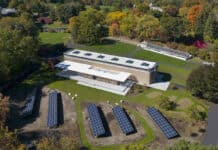Growing concern over the threat of a major earthquake in California has sparked a statewide movement for resiliency and pending legislation that calls for the identification of buildings most vulnerable to seismic damage and collapse.
Scientists say that stress along the San Andreas fault has been building with little relief since the mid-1800s. The next “Big One” – which could come at any moment – could be of a magnitude of 7.5 or more. The force of that quake could result in twice the damage of Hurricane Katrina and be up to 45 times more destructive than the Northridge earthquake, they say.
A new white paper, “The Case for Earthquake Resilience: Why Safer Structures Protect and Promote Social and Economic Vitality,” describes in depth the threats of earthquakes on society, and the economic benefits that come from having safer structures in a community.
The paper was written by key members of the Seismic Resilience Initiative (SRI), a working group led by the United States Resiliency Council that includes BizFed, Local California Building Department Leaders, the Structural Engineers Association of California and others with technical assistance from the California Seismic Safety Commission, California Office of Emergency Services, the California Department of Insurance, and the International Code Council. The mission of SRI is to promote statewide policy that will identify buildings known to present a heightened seismic risk of death, injury and damage based on their age, structural system, size and location.
Meanwhile, AB2681, inspired by SRI and introduced Feb. 15 by California Assemblyman Adrin Nazarian – a longtime advocate for earthquake preparedness – aims to help cities identify buildings in their communities that could be at significant risk during a major quake, and to establish funding sources to help cover the costs to cities impacted by the law. This snapshot of California’s vulnerabilities will provide a thorough assessment of the potential impacts facing the state, and will spotlight communities where there is an urgency to address the matter.
The legislation, if adopted, will:
- Develop criteria to identify seismically vulnerable building types.
- Direct building departments to develop an initial list of potentially vulnerable buildings.
- Notify building owners that they may have potentially vulnerable buildings.
- Direct noticed owners to verify the vulnerability of the structure.
- Build and maintaining a statewide data repository of potentially vulnerable buildings.
- Identify possible funding mechanisms to offset costs to building departments.
“The identification of these buildings is an important step in ascertaining the extent to which our cities are threatened,” Nazarian said. “We have to identify our weaknesses in order to make our communities stronger.”
Certain structures are more prone to damage from seismic shaking, noted Evan Reis, executive director of the United States Resiliency Council. This generally includes older wood-framed, soft-story structures, unreinforced masonry, tilt-up, nonductile concrete, and steel moment frame buildings.
“Every building made stronger represents added potential for communities to spring back from a major earthquake,” Reis said. “This is very important not only in terms of saving lives, but in preserving social and economic order.”
Retrofits not only safeguard communities, but building owners, too, according to white paper co-author David Khorram, President of California Building Officials and superintendent of building safety for the city of Long Beach.
“Researchers have found that retrofits bring significant cost benefits to the building owners,” he said. “In the end, it makes good business sense. It protects an owner’s equity and income, and guards against potential liabilities.”
White paper co-author Ali Sahabi, chief operating officer of Optimum Seismic, Inc., board member and officer of BizFed, and a longtime champion of sustainability, stressed the important impact that resilient communities have on the well-being of the state, and the nation.
“Planning for disaster before it strikes is a major component of sustainability,” he said. “Foresight and preparation are our only defense against major earthquakes. What we do today as a society will impact our communities long into the future.”



















![[VIDEO] Collect Asset Data at the Speed of Walking a Building](https://facilityexecutive.com/wp-content/uploads/2024/02/maxresdefault-324x160.jpg)